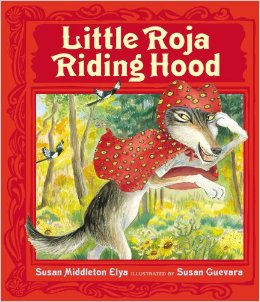| Home | ||
     
| ||
|---|---|---|
| Little Roja Riding Hood | ||
|
Illustrated by Susan Guevara
Illustrations on this page are copyrighted by Susan Guevara and Loretta Lopez. |
|
Awards *Pura Belpre Illustrator Award Reviews Publisher's Weekly Elya remains a master at blending Spanish and English to create clever, lively verse, and she and Guevara give the story of Little Red Riding Hood an entertaining and thoroughly modern spin. Roja’s mother is busy watching telenovelas, so she sends her daughter to deliver sopa to her ailing Abuela. Riding on an ATV, Roja meets a wolf (“¡Cuidado! !Cuidado!” wail the forest birds in a kind of Greek chorus), who beats her to Abuela’s house. Guevara tucks fairy tale and nursery rhyme characters throughout her watercolor-and-gouche paintings, and Roja’s tech-driven solution to prevent future break-ins will leave readers smiling. Ages 5–8. The Horn Book Little Red rides an ATV to deliver la canasta (basket) to her ailing abuela in this hip updated version of the traditional tale. Liberally sprinkled with Spanish words and phrases, the rhyming text is fresh and funny (“‘Abue,’ he said in a high squeaky voz, / ‘I’m sorry to hear of your terrible tos’”) and often unexpected. (For example, “basket” is rhymed with “who asked it?”) And just as clever as the quirky text are the watercolor, ink, and gouache illustrations that contain plenty of humor and multiple layers of meaning. The Three Blind Mice accompany Little Roja on her journey, while three magpies follow and call out warnings that appear in flowing ribbons that act as dialogue bubbles. Two little trickster elves make mischief throughout. But best of all is Abuela herself, shown here as an aging hippie who appears to be working on a manuscript revision in her sick bed. She doesn’t really need rescuing — she protects herself by holding up a statue of St. Jude; Little Roja joins in by throwing a pot of hot sopa at the wolf. Once the wolf is vanquished, capable Abuela discourages future intruders by installing a security sistema, while Little Roja trades in her red hood for one with tiger stripes. An inventive spin on a familiar tale, this will stand up to repeated readings and viewings. Youtube review - Marisol Herrera Starred review -August Horn Book Little Red rides an ATV to deliver la canasta (basket) to her ailing abuela in this hip updated version of the traditional tale. Liberally sprinkled with Spanish words and phrases, the rhyming text is fresh and funny (“‘Abue,’ he said in a high squeaky voz, / ‘I’m sorry to hear of your terrible tos’”) and often unexpected. (For example, “basket” is rhymed with “who asked it?”) And just as clever as the quirky text are the watercolor, ink, and gouache illustrations that contain plenty of humor and multiple layers of meaning. The Three Blind Mice accompany Little Roja on her journey, while three magpies follow and call out warnings that appear in flowing ribbons that act as dialogue bubbles. Two little trickster elves make mischief throughout. But best of all is Abuela herself, shown here as an aging hippie who appears to be working on a manuscript revision in her sick bed. She doesn’t really need rescuing—she protects herself by holding up a statue of St. Jude; Little Roja joins in by throwing a pot of hot sopa at the wolf. Once the wolf is vanquished, capable Abuela discourages future intruders by installing a security sistema, while Little Roja trades in her red hood for one with tiger stripes. An inventive spin on a familiar tale, this will stand up to repeated readings and viewings. (Kathleen T. Horning) School Library Journal blurb Elya’s version of the familiar story has a rhyming text and uses Spanish words throughout, sometimes as a way of creating rhymes. The rhythm and rhyme scheme are spot-on, making this a great choice for reading aloud. The grandmother character is particularly likable. She is not about to be saved by any random woodcutter who happens to be wandering through the forest. She’s totally buff, and prepared to dispatch the wolf on her own! Guevara, who won the Pura Belpre Award for illustration for Gary Soto’s “Chato” books (Putnam), provides the rollicking images in this reworking of the fairy tale. School Library Journal review Guevara. 32p. glossary. Putnam. Apr. 2014. Tr $16.99. ISBN 9780399247675. LC 2012022545. Booklist review
The author of Fire! Fuego! Brave Bomberos (2012) offers here another rhyming bilingual picture Kirkus review Elya presents a modern twist on a familiar fairy tale in her signature style using rhyming, predominantly English text that skillfully incorporates Spanish words and phrases. Red travels through the woods to take hot soup to her sick abuela. Along the way, she is tricked by a sly wolf. Roja must act quickly to rescue Grandma, and then the two devise a technologically enhanced plan to prevent visits from unwelcome predators in the future. The playful illustrations elevate the book, blending a whimsical fairy-tale land with contemporary Latino-American life. In the kitchen, where Mamá watches telenovelas while chopping peppers and garlic, three blind mice scamper about, a pair of mischievous goblins lurk outside the window, and symbols reminiscent of milagros, or prayer charms, rise up in the steam from the clay pot of bean soup. As Red travels through the forest, the birds call out warnings to her in Spanish—“¡Cuidado!” Throughout the text, the Spanish words appear in bold and italicized print. Context and an opening glossary provide the definitions rather than simultaneous translation. This results in a story that avoids becoming repetitive for bilingual readers and that readers who do not speak Spanish will also easily understand. This spirited interpretation of a classic fairy tale successfully mixes magic and reality, as well as Spanish and English words. (Picture book. 3-7)
|
||
